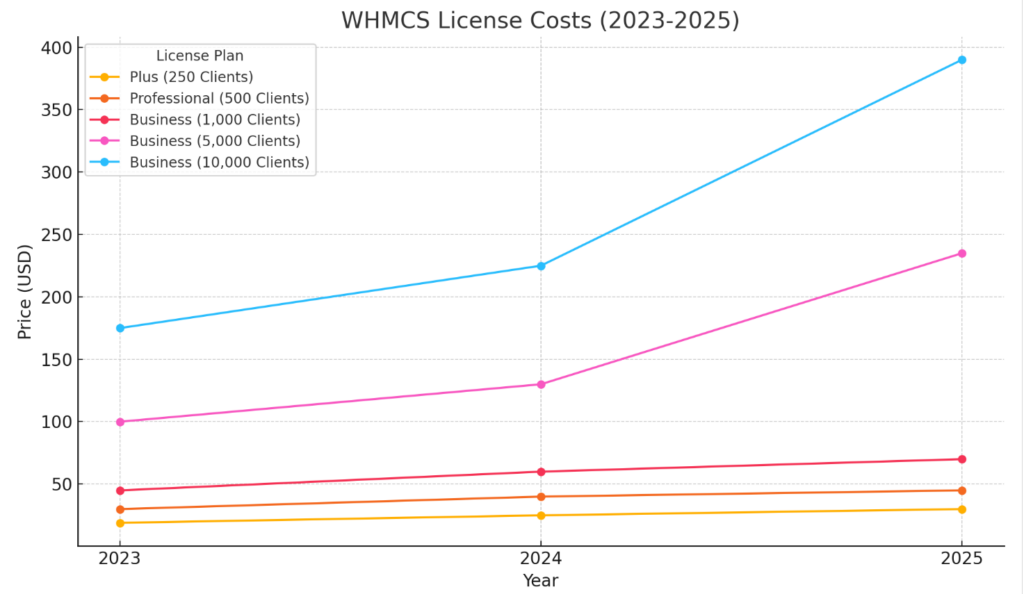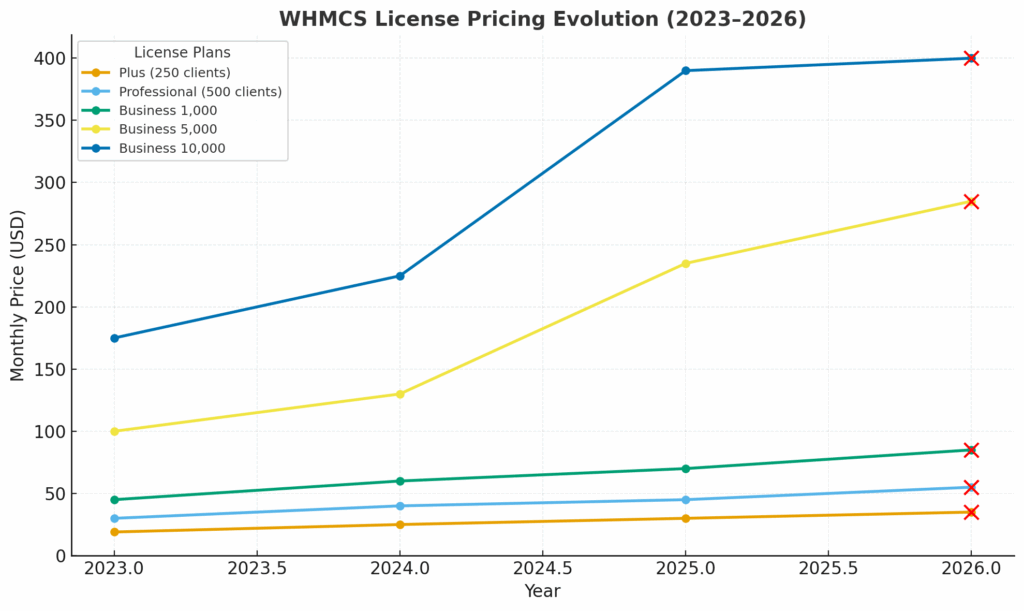Change is coming to the world of web hosting automation – and it’s going to affect nearly every WHMCS user. Early in 2026, specifically on January 1st, WHMCS will roll out a new pricing structure that marks one of the most significant adjustments in recent years. For many hosting providers, developers, and digital agencies, this announcement has already sparked conversations and some concern about rising operational costs and long-term sustainability.
As the backbone of billing, automation, and client management for thousands of businesses worldwide, WHMCS has long been valued for its flexibility and integration power. Yet, with every update to its pricing model, questions resurface: how will these changes reshape the economics of running a hosting business? And, more importantly, is the new pricing still worth it?
WHMCS pricing evolution: A steady climb toward 2026
Over the past few years, WHMCS pricing has followed a clear and consistent upward trajectory – one that has gradually prepared the market for the upcoming 2026 adjustment. Back in 2023, the entry-level Plus license cost just $18.95 per month, covering up to 250 active clients. By 2024, that same plan rose to $24.95, and by 2025 it reached $29.95, marking a 58% increase in just two years.
The Professional tier, designed for up to 500 clients, has experienced a similar climb. Priced at $29.95 in 2023, it jumped to $39.95 in 2024 and currently stands at $44.95 per month. This gradual scaling mirrors WHMCS’s attempt to align pricing with the growing complexity of its user base and expanding feature set.
More noticeable, however, are the shifts within the Business segment. The smallest Business license, which allows for up to 1,000 clients, rose from $44.95 in 2023 to $59.95 in 2024, and currently costs $69.95. Larger Business tiers – supporting up to 5,000 or even 10,000 clients – have seen much sharper increases. For instance, the 5,000-client plan surged from $99.95 in 2023 to $234.95 in 2025, while the top-tier 10,000-client license nearly doubled from $224.95 in 2024 to $389.95 in 2025.

These numbers paint a clear picture: WHMCS pricing has been steadily escalating year after year, with each stage seemingly setting the stage for what’s coming next. The 2026 update isn’t a sudden shock – it’s the culmination of a multi-year strategy aimed at repositioning WHMCS within a more premium software tier. The question now is just how steep the next step will be, and how much value businesses can expect in return.
WHMCS 2026 pricing: A sharp turn toward premium
The newly announced WHMCS pricing for 2026 confirms what many in the hosting industry anticipated – another upward leap, this time more pronounced than in previous years. The Plus plan, previously priced at $29.95, will rise to $34.95 per month, while the Professional license climbs from $44.95 to $54.95 per month. These increases, though moderate in isolation, mark a clear continuation of WHMCS’s premiumization strategy.
The Business tier, however, shows the most significant transformation. The entry-level Business 1,000 license will jump from $69.95 to $84.95 monthly, and larger packages expand into territory rarely seen before in WHMCS pricing. For instance, Business 2,500 grows to $179.95, Business 5,000 reaches $284.95, and the 10,000-client plan now costs $399.95 per month. What’s more, WHMCS has introduced entirely new upper tiers – stretching up to 100,000 clients and even an unlimited license – with prices ranging from $1,249.95 to a striking $1,999.95 per month.

This signals a definitive repositioning of WHMCS toward the enterprise market. What was once an accessible tool for small and mid-sized providers is now shifting into a pricing bracket that reflects large-scale infrastructure management and corporate-grade support. The message is clear: WHMCS in 2026 is no longer just a billing solution – it’s a high-end automation platform, and it’s pricing itself accordingly.
Frustration over prices and stagnation
The WHMCS community has once again voiced its frustration following the announcement of the 2026 price increase. While reactions on the official forum have been somewhat restrained compared to the outrage seen during earlier WebPros-related price hikes, the sentiment remains largely negative. Many long-time users express growing disappointment – not only because of the higher licensing costs, but also due to the perceived lack of meaningful progress in the platform’s development.
Several contributors note that despite the steady rise in subscription fees, WHMCS has introduced few improvements that directly benefit hosting providers. Some users accuse the company of neglecting long-requested updates, while others complain that useful features have been removed rather than enhanced. The most common grievance is that the value proposition no longer matches the pricing – users feel they are paying more each year for essentially the same software.

Interestingly, a few participants acknowledge that WHMCS still delivers solid stability and reliability, which makes it difficult to abandon entirely. However, patience appears to be wearing thin. Competitors like WISECP and Blesta are increasingly mentioned as modern alternatives offering faster innovation and more transparent communication.
On the other hand, a WHMCS representative tried to calm the discussion by announcing the upcoming release of a RESTful API and a new, modern client area based on Vue.js, suggesting that tangible updates are indeed on the way. Still, the overall tone of the community remains skeptical – many users want to see real, practical improvements before accepting yet another price hike.

What comes next for WHMCS and its users
Looking ahead, WHMCS users face a familiar but increasingly uncomfortable dilemma. The 2026 pricing update cements a pattern of yearly increases that, for some license tiers, now add up to several hundred percent over just a few years. Yet despite these growing costs, many providers feel trapped by circumstance – locked into the platform by years of data, automation, and client integrations that make migration both technically complex and financially risky.
The community’s patience is clearly wearing thin. While WHMCS remains a stable and widely supported system, the lack of innovation and the perception that user feedback is being ignored have eroded much of the goodwill that once surrounded the brand. If genuine progress in development fails to materialize – particularly around long-requested improvements to automation, UI, and integrations – the stage may finally be set for alternative platforms to gain serious ground.
Still, for small and mid-sized hosting companies, switching away from WHMCS is easier said than done. Competing systems like WISECP, Blesta, or HostBill continue to evolve but have yet to fully match WHMCS’s ecosystem, especially when it comes to module availability and third-party support. For now, most users seem resigned to stay, hoping that the next round of updates will finally justify the ever-rising subscription fees.
In the months ahead, the real question will be whether WHMCS can balance its move toward premium pricing with tangible product growth – or whether the 2026 increase will be remembered as the moment loyal users began seriously planning their exit.
